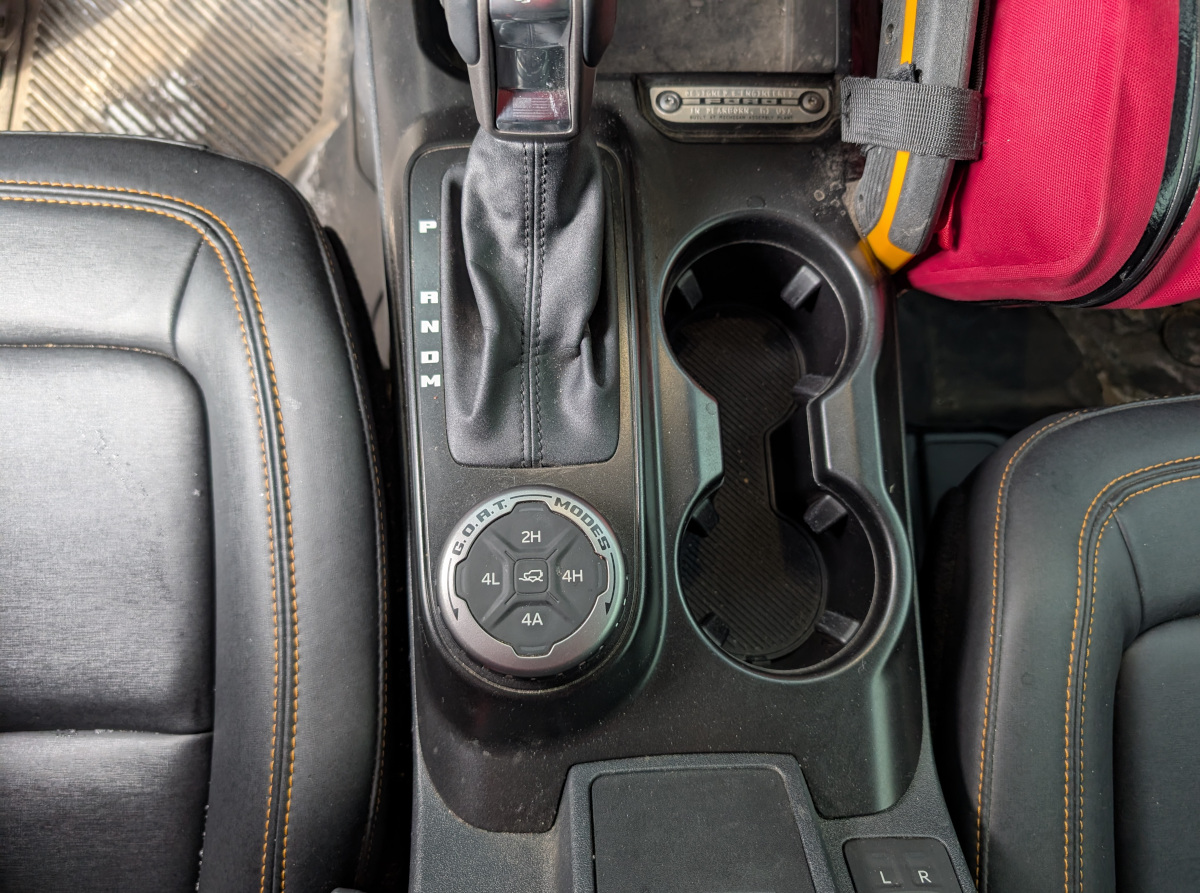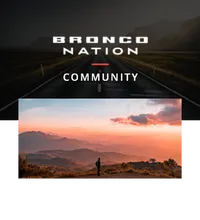Our rear-wheel drive Broncos can go fantastic places, but not without traction. Good thing we have a way to find more, via our transfer cases. Four-wheel drive doubles the amount of grip available by engaging the front axles, giving all four wheels a chance to catch.
With the push of a button, you can move your Bronco out of 2H and into a four-wheel drive range. Low range requires a transmission shift into Neutral first, but even with the extra step, it's incredibly easy to get more out of your vehicle almost instantly.
At Home with All the Ranges
All Broncos, from the Base trim to the Raptor, have 4H and 4L, and some –– depending on what came standard or how the individual vehicle was spec'd –– have one more option on the transfer case: 4A.
This isn't news to most: Many of us bought the Bronco exactly for its four-wheel drive capabilities. But if you're newer to off-roading, traveling to an unfamiliar terrain or climate, or can't get out to try stuff as often as you'd like, navigating the selections might have you feeling unsure. When's the right time to use which range?
Ford includes G.O.A.T. Modes on your Bronco, which adjust various vehicle settings at once for different driving conditions. You can learn more about them in our video below or through your owner’s manual.
However, if you want to shift your transfer case on your own, and better understand which Mode to select, read on! We cover the basics, so your Bronco can cover the most ground.
Popping It Into 4 … What?
Unless you’re lucky, most days, your Bronco will be in 2H, or 4A if you have it and like using it on-road. Then comes the times your vehicle can really shine: trail days or poor weather conditions. It’s time to shift the transfer case.
If you’ve checked the owner’s manual, you know it can help you decide, but certain terrains and conditions, like sand and mud, appear under both high and low range:
4x4 With Part Time Engagement
- Two-Wheel Drive High (2H): Sends power to rear wheels only. Two-wheel drive high is for general on-road driving.
- Four-Wheel Drive High (4H): Mechanically locks power to the front and rear wheels for off-road or slippery conditions, for example: snow, ice, sand, or mud. This mode is not for use on dry pavement.
- Four-Wheel Drive Low (4L): Mechanically locks power to the front and rear wheels and provides increased gearing for added torque in severe low traction off-road conditions, such as: deep sand, mud, on steep slopes, or when pulling heavy objects.
Snow is another you’ll need to consider on a case basis.
Read: Best Bronco G.O.A.T. Modes for Winter Weather and Off-Road Driving and 3 Cylinders in the Sand?
Advanced 4x4 With Automatic On Demand Engagement

- Includes everything above, plus:
- Four-Wheel Drive Auto (4A): Continuously varies power to the front wheels for optimal on-road performance in all weather conditions.
Breaking It Down
We go over some guidelines for terrain variables and other four-wheel drive situations, like water crossings, at the end of the article. Skip ahead if you’re searching for this information in a pinch.
If you have some time, first review how traction works, what makes low range special, and why seat time matters more than anything. Knowing what’s behind the guidelines will make it easier to set your Bronco up for all the situations you come across.
Traction Gets that Bronco in Action
Traction is a pretty simple concept, one anyone who’s ever taken a shower can understand. Slip standing on one leg, and you’re going down. Slip, but with the other leg planted on less sudsy tile, and you’ll likely stay standing but look funny trying to do so.
Traction in a vehicle is the same. The more wheels gripping the ground at once, the better the outcome. Four-wheel drive gives you two extra chances for the engine’s torque (the twisting force that turns your wheels) to be funneled into motion: Four wheels have hopes of finding solid footing, increasing your odds of maintaining momentum even if some are slipping.
Getting going isn’t as simple as shifting into four-wheel drive and puttering off, however. The ground surface, tires, your Bronco’s weight, weight transfer, and even too much torque can keep your Bronco spinning in place. Grip comes from ground pressure (your tire footprint pressing down) and the ground surface. Add torque to grip, and that’s traction.
Read: How and Why to Properly Air Down an Off-Road Vehicle
The Beauty of 4L
Low range works differently than high range. Four high (like 2H) uses a 1:1 ratio to send power to the axles. For every revolution of the transmission output shaft, the transfer case output shafts rotate once. In 4L, the transfer case multiples the torque coming from the engine with a lower gear set.
Shorter gears reduce the speed of the drivetrain. The 4x4 With Part Time Engagement transfer case has a low ratio of 2.72:1 (2.72 turns of the transmission output shaft = one turn of the transfer case output shafts, increasing torque 2.72x). The Advanced 4x4 With Automatic On Demand Engagement transfer case has a low ratio of 3.06:1.
What’s the benefit for you? That much more torque, which can give you increased control in low-speed situations that benefit from having maximum traction, like rock crawling, steep inclines and declines, and pulling heavy objects.
Understanding what makes 4L different from 4H may help you start choosing which range to use on your own.
A Word on Seat Time
Head knowledge is great. There are certain off-roading rules that will always apply –– things like turn downhill, not up, if a roll feels imminent, or get off the brakes and give it some throttle if your back end is trying to pass your front coming down off an obstacle.
But some skills, like throttle control, knowing when to bump it, and even what range to be in for the snow or mud type in front of you and the speed to take it at, can only be picked up by seat time. Seat time in your specific setup will help you the most.
Tires, wheelbase, center of gravity, and more make your rig perform different than others, and you’ll develop an instinct for what your Bronco can do, and if your skills will get you into or out of a sticky situation.
In conclusion, four-wheel drive powers both axles, increasing your chances of keeping traction, but it doesn’t guarantee it. Spending time developing your technique can take you father than all the ranges, lockers, and clearance one could hope for in untried hands.
Skip to It | At-a-Glance Use Cases
Using 4L

Four low is great for slow-speed, high-torque situations. The extra torque provides more grunt with less demand on your engine. Just watch your throttle input and go slow and steady to avoid shock load damage on obstacles. Another benefit of 4L: engine braking on steep declines.
Use it off-road for:
- Pulling a boat out of the water
- Recoveries
- Rock crawling
- Steep hill climbs where you need to maintain a steady momentum
- Hill descents
- River crossings
- Mud that requires steady speeds to get through (usually thick, gooey, and sticky)
- Heavy or deep sand
- Deep, wet snow
You can stay in 4L most of the time on the trails, until you start picking up speed to not over-rev the engine. If you start topping out on your speed, switch to 4H.
Using 4H

Four high lets you run with more control at higher speeds.
Use it for:
- Continuous snow and ice on paved roads
- Dirt and gravel trails with loose surfaces
- Powdery snow off-road
- Soft and hard-packed sand
- Greasy, watery mud that benefits from wheel spin to clear treads
Just remember, four-wheel drive helps with acceleration, but it won’t help you stop faster. Drive at safe speeds for the conditions.
Using 4A

Of the “fours,” use only 4A on dry on-road surfaces.
Use it for:
- Wet weather conditions
- Snowy roads with patches of cleared or dry areas
- Optimal performance no matter the weather
Master Your Bronco

The Bronco gives you plenty of ways to keep moving forward, from the preset G.O.A.T. Modes to shifting the transfer case and applying lockers on your own. If this information has you wanting more, head to Bronco Off-Roadeo and learn more about the owner experiences and Half Day Adventures available for you.
Join a club, and watch for (or set up) an event near you. Finally, ask questions below or in the Bronco forums; there are lots of awesome, knowledgable people who would be happy to help you learn how to get the most out of your vehicle!

Comments
You must log in or register to post here.